His June 18, 1996 obituary in the Fort Worth Star-Telegram is short and succinct.
Lawrence M. Peters, 78, a retired Allied Mills employee, was found dead Friday [June 13] in Teague. Funeral: 11 a.m. today at Avant A.M.E. Church in Teague. Burial: Fairfield. Mr. Peters retired in 1982.
It’s not much of a lede, but it’s where we should start.
Lawrence M. Peters died on June 13, 1996, and his obit ran on June 18. No picture. No next of kin listed. No mention of his loved ones.
Most of the obits around it have pictures of the deceased, several lines about the lives they led, and a list of survivors. Peters’ is uninteresting.
It brings to mind an old English expression long claimed to be a Chinese curse: “May you live in interesting times.” The adage is foreign to us, especially as social media trumpets the ways in which our lives are interesting, but in the old days, “interesting times” were often times of tribulation or danger.
Lawrence M. Peters’ obit is boring but misleading. He lived in very interesting times.
In the early 1950s, he worked as a bin stocker at Allied Mills on 401 N. Beach St. It’s not clear where he lived before, but by 1953, he was 35 years old and making $55 a week. He and his wife had been saving for a while, and they had enough to finance a house. A decent house in the Riverside neighborhood just east of downtown Fort Worth. It was also just a five-minute drive to his job. He was living the American Dream, right here in Cowtown.
He paid $1,278 down on a two-bedroom frame home at 109 N. Judkins, and trouble began as soon as he unpacked on August 21, 1953.
Mr. and Mrs. Peters were Black. The Riverside neighborhood was white.
The “good” white citizenry of the neighborhood took immediate (though, perhaps in their minds, tactful) action. Upstanding white community leaders like George A. Seaman (a former city councilmember), Mack Dumas, Rayford M. Shelton, and George Brown formed the Riverside Merchants and Home Owners Association in response to the new residents. The association didn’t want their nice, respectable suburbia encroached upon by “Negroes.” Seaman and other association members met with Peters and offered to pay his down payment plus equity and moving expenses to leave.
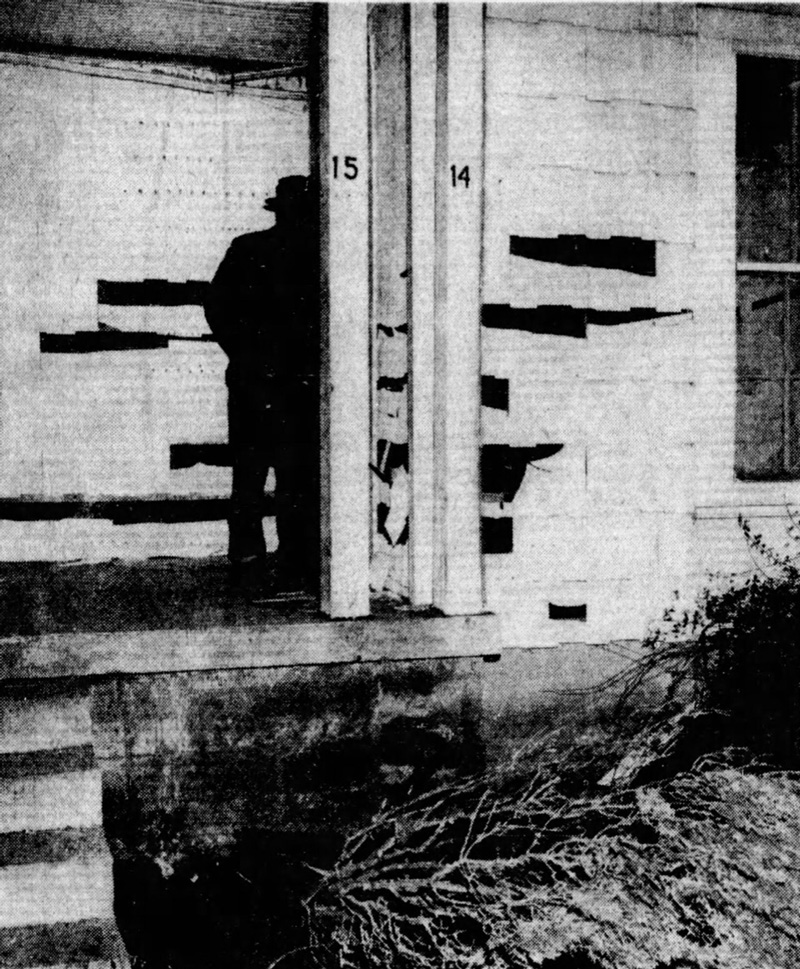
Courtesy Fort Worth Star-Telegram archives
“I want to stay,” Peters told the Fort Worth Star-Telegram. “I worked hard and saved my money to buy a clean, decent home. I went to the real estate company to buy a house, and they sold me this one. I don’t want any trouble with anyone. I wouldn’t have moved in here if I’d had any idea it would upset these people, but now I’ve gone to the trouble of moving, and it’s a nice home. I’d like to stay. I’ll be a good citizen and a good neighbor.”
On August 25, 1953, the real estate firm that sold the Peters couple their home announced it was canceling all future listings in the area “as a result of white protests over its and other companies offering homes for sale to Negroes.”
But others slipped through.
On Saturday, Sep. 26, an unidentified Black family tried to move into 113 N. Judkins — the house right next door to the Peters residence — and a belligerent crowd of white protesters gathered and told them they were not welcome. The white mob was so unnerving and threatening that the incoming Black family loaded back up before they were even unpacked and left.
When Peters returned home later, the white mob warned him, shouting that they “would put a bomb under” his car. Seaman later insisted that a number of folks “heckled the Negroes moving into the house” next door but that no one had threatened Peters.
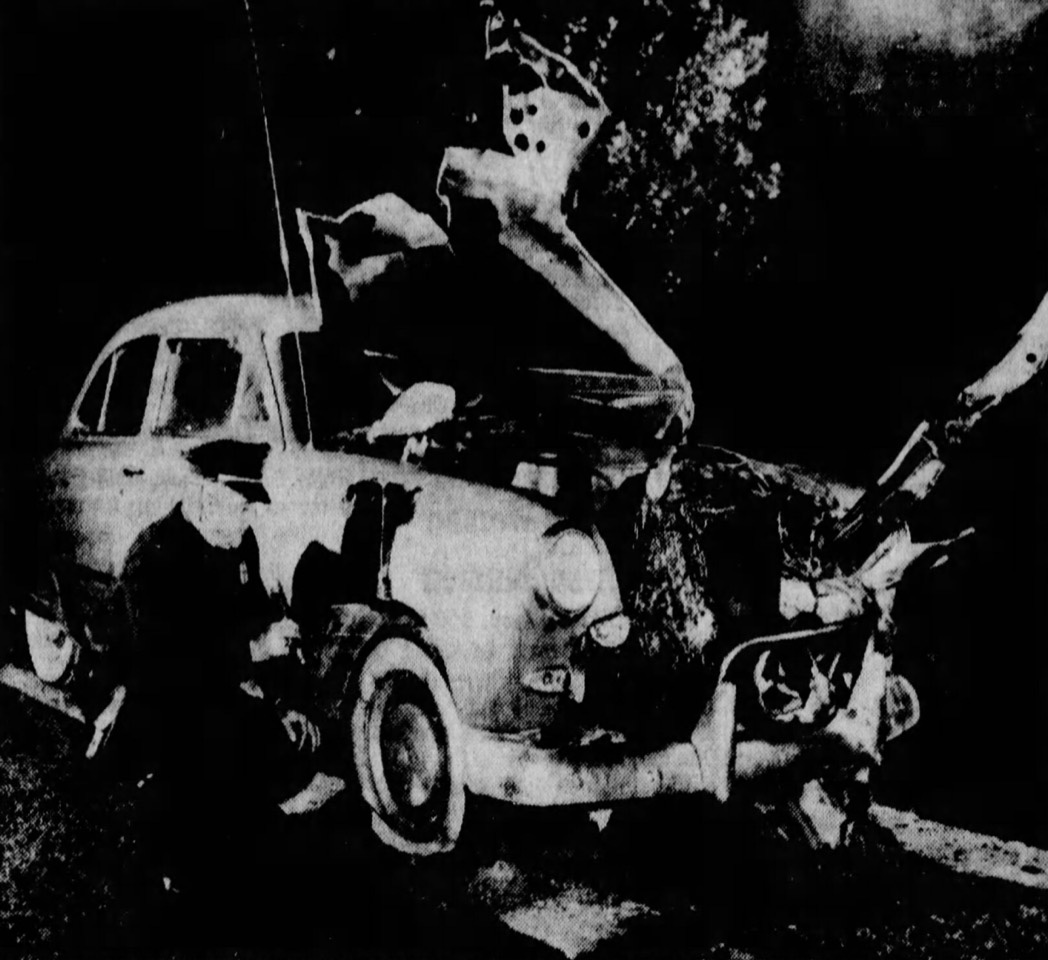
Courtesy Fort Worth Star-Telegram archives
“Some of them just yelled at him that he had missed a party by coming home so late,” Seaman said. “This is not a temporary deal. We’re going to see this thing through, and we’re going to win.”
Seaman and the others planned meetings all over Riverside. “And by Riverside,” Seaman clarified, “I mean Oakhurst, Haltom City, Oak Knoll, and Richland Hills.”
The Riverside Merchants and Home Owners Association membership was limited to individuals who signed affidavits affirming that they were not Communists, that they would do “nothing to devaluate Riverside property,” and that they were “Caucasians in race.”
On Monday, Aug. 31, the Fort Worth branch of the NAACP proposed the creation of a mayor-appointed biracial commission to promote a better understanding between whites and Blacks in the area. In an official statement, they issued constructive advice to all parties: “Look for qualities that are more than skin deep, and you will get excellent neighbors. If the people of Riverside and other areas in Fort Worth can begin judging neighbors on this democratic basis, we can contribute to the advance of human relations and serve as a model community in housing for other areas of these United States.”
Soon, signs reading, “This house not for sale to Negroes” began greeting Peters from homes up and down his street. Then, during the wee hours of November 2, 1953, the empty residence at 113 N. Judkins was doused in gasoline and burned, and several sticks of dynamite were placed under the hood of Peters’ car and detonated. The explosion blew out the front living room windows of the Peters house, and Peters was frustrated and defiant. When a reporter solicited his response after the attack, he was bitterly unequivocal.
“Tell them I’m going to stay,” Peters said. “Tell them I’m not going to move out.”
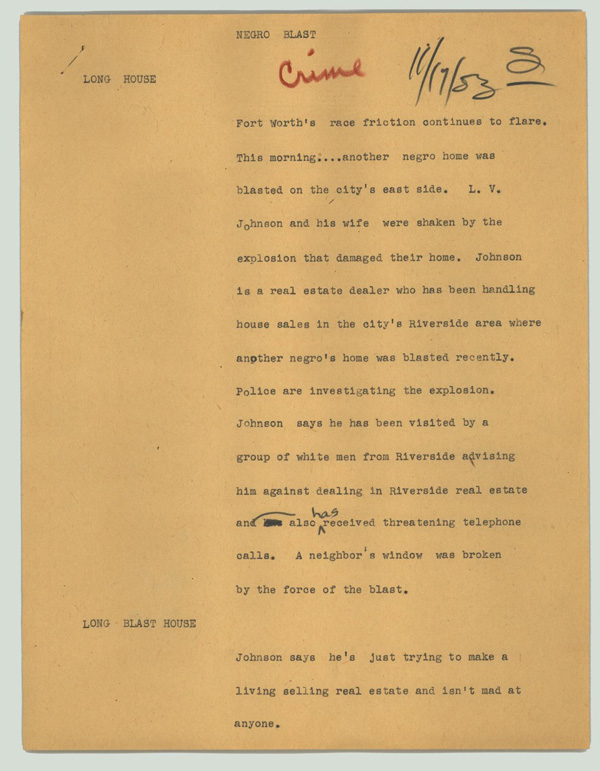
After worrying for several hours that Monday, Peters contacted the FBI. After explaining his predicament to an aide of FBI Director J. Edgar Hoover, he spoke with Hoover himself. “I told him I needed protection because the police here didn’t seem to be doing anything.”
Hoover listened patiently and promised Peters he would send agents to Fort Worth to investigate. He never did. Mack Dumas from the Riverside Merchants and Home Owners Association suggested that the bombing may have been perpetrated by allies of the Negroes “to gain sympathy for their cause.” Some claimed Peters had created a “Frankenstein” by moving to the Riverside area and that he couldn’t leave 109 N. Judkins because he would be “letting other Negroes down.”
Peters scoffed at the notion and stated that he was staying in the home for himself — “individually, not for other Negroes. I feel it’s right. I bought the house with good intentions, and one of the intentions was to stay, so I’m going to.”
On Tuesday, Nov. 17, a second bomb detonated, shaking the home of L.V. Johnson, a Black 54-year-old real estate agent who had been handling house sales in the Riverside neighborhood for months. The blast, which was the result of dynamite placed near Johnson’s front steps, occurred at 1:45 a.m. at 1514 Kennedy in a Black neighborhood near I.M. Terrell High School. The explosion chipped concrete, ripped siding, uprooted shrubbery, and shattered the windows of Johnson’s property and a neighbor’s. Johnson told WBAP-TV (now NBC 5) that he was just trying to “make a living.”
Johnson, whose house was two miles away from the Peters residence, had been visited and warned by a number of white Riverside residents and was regularly receiving threatening phone calls. He bemoaned the unfair treatment.
“It’s just a business with me,” Johnson told the Star-Telegram. “I sell houses to a lot of people. This is my living, and I have to do it. It’s true that some white people have listed their houses with me. All the white people came to me. I never went to them for the business.”
The following day, the Fort Worth branch of the NAACP offered a $250 reward for any information that could help local authorities arrest and prosecute the individuals involved in the recent bombings in the area, but no one stepped forward.
For the next several months, white animosity in the Riverside community simmered steadily but revealed itself in more passive-aggressive ways. This changed on Saturday, Sep. 11, 1954, when dynamite was placed under the car of a Dunbar Junior High School English teacher named Kerven W. Carter Jr. in front of his home at 5736 Diaz, near Lake Como. Carter, his wife, and their 3-year-old son were awakened by the blast at 1:11 a.m., and the bombing method and pattern matched the earlier incidents involving Peters and Johnson.
Carter’s parents had moved to 158 N. Judkins — situated between two white families — just nine days earlier, and Carter had been harassed when he visited them and then forced to contend with phone calls from people who wouldn’t speak when he or his wife answered.
Seaman was surprised, though he noted that even though the number of Black residents in the Riverside area was growing, the Riverside Merchants and Home Owners Association hadn’t had a meeting in months.
“This is a bad thing,” Seaman told the Star-Telegram. “What this city needs is for a Negro to move into TCU, Ridglea, Westcliff, or Westover Hills. Then, they’d see what our problem is out here.”
The bombing destroyed Carter’s 2-year-old vehicle and blew out some of the windows in his house.
*****
According to a report by the City of Fort Worth titled Historic Context of Fort Worth: Postwar Suburbanization and Development, 1946-1980, a “shifting demographic played out in neighborhoods including Morningside, Van Zandt, Terrell Heights, and Riverside, where Black families moved, as well as in Diamond Hill, where Latino families relocated. The integration prompted some white families to leave these neighborhoods and move to new, outlying, predominantly white suburbs. Other white families remained, and in some cases the integration resulted in racial tensions and violence. In Van Zandt and Morningside, white residents staged demonstrations, and at least one dynamite bomb was placed on the porch of a Black-owned house. The worst case of racial violence, though, occurred in Riverside, where protests, house burnings, and bombings occurred for several years in the late 1950s.”
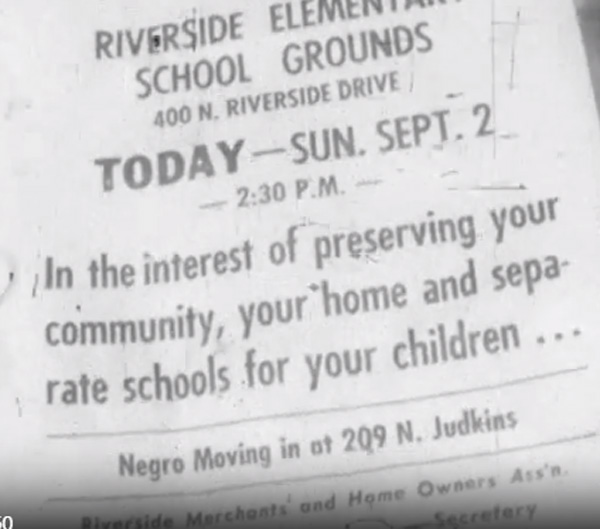
A WBAP report from September 2, 1956, illustrates this point. It begins with images of a flyer announcing a meeting at the Riverside Elementary School “in the interest of preserving your community, your home, and separate schools for your children” and saying that a “Negro [is] moving in at 209 N. Judkins.” The wording at the bottom of the flyer indicates it was created by the Riverside Merchants and Home Owners Association. The clip then features images of E.G. Brown speaking to white citizens, calling for action against a Black man named Lloyd Austin and his family, who are the new residents of 209 N. Judkins. About 200 whites — men, women, and children — attend the meeting and plan a protest march in front of the Austin family’s new residence. The clip then introduces Diamond Hill resident Jack Lamont and records him admitting he’s “for hanging Negroes” as he prepares signs for the protest. Next up is Seaman, who recommends that economic pressure be applied at Lloyd Austin’s and his wife’s places of employment to get them fired.
The next bit of footage chronicles the white crowd leaving Riverside Elementary School with their signs and heading for 209 N. Judkins. The white mob is transported by automobiles and soon floods the street and sidewalks of the 200 block of N. Judkins with defiant white faces and their signs. One says, “Nigger Get Out.” Another says “Better STAY OUT NIG and stay alive.” Fellow Black residents along the street, including Peters, join Lloyd Austin in his house. Police arrive and monitor the situation but eventually depart.
Near dark, a group of approximately 40 white boys gather in front of the Austin home and hurl rocks and soda bottles at it. Fifty other white residents stand and simply watch. Several windows in the Austin home are shattered, but the police are no longer around. Then shots are fired.
The next footage shows a crowd surrounding a car parked in front of the Austin residence. The camera captures bullet holes in the hood and the radiator of the vehicle.
Later, the white youths display an effigy they had reportedly hanged in a nearby tree. They say a Negro man cut it down. The Fort Worth police return and begin dispersing the white crowd and send the boys home.
****
The 70th anniversary of the beginning of this reign of domestic terror in Fort Worth was November 2. Very few people in Fort Worth remember or acknowledge it, and any books or textbooks that might discuss the incident and others that followed would probably not be allowed on the shelves of Fort Worth schools or public libraries, but Lawrence M. Peters refused to give up his seat on the proverbial bus two years before Rosa Parks. And he stood up before Martin Luther King Jr. and Malcolm X right here in Fort Worth, and none of us have ever heard of him. “Lawrence M. Peters” is just 30 dispassionate words in a forgotten 1996 obit.
We all know the drill.
What’s done is done, and it was done by somebody else to somebody else. And it’s still being done today.
Even though we live in interesting times, we clearly don’t care. Our chief preoccupation is selective disinterest.
Fort Worth native E.R. Bills is the author of Tell-Tale Texas: Investigations in Infamous History.



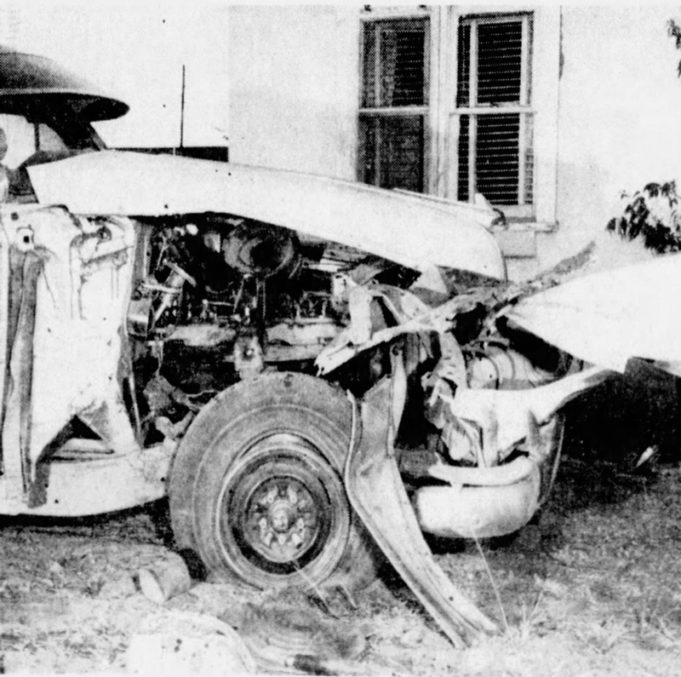









“Still being done” WTF are you talking about????